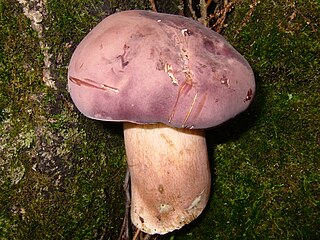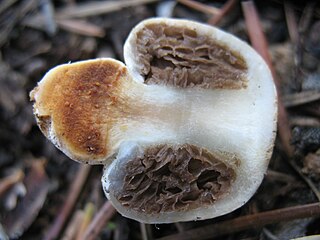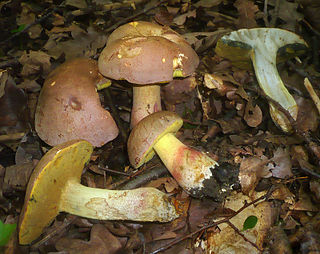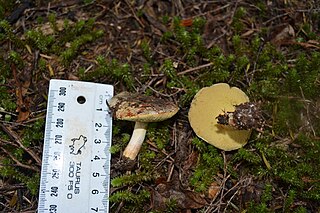
Boletus edulis is a basidiomycete fungus, and the type species of the genus Boletus. Widely distributed in the Northern Hemisphere across Europe, Asia, and North America, it does not occur naturally in the Southern Hemisphere, although it has been introduced to southern Africa, Australia, New Zealand, and Brazil. Several closely related European mushrooms formerly thought to be varieties or forms of B. edulis have been shown using molecular phylogenetic analysis to be distinct species, and others previously classed as separate species are conspecific with this species. The western North American species commonly known as the California king bolete is a large, darker-coloured variant first formally identified in 2007.

The Boletaceae are a family of mushroom-forming fungi, primarily characterised by small pores on the spore-bearing hymenial surface, instead of gills as are found in most agarics. Nearly as widely distributed as the agarics, the family is renowned for hosting some prime edible species highly sought after by mushroom hunters worldwide, such as the cep or king bolete . A number of rare or threatened species are also present in the family, that have become the focus of increasing conservation concerns. As a whole, the typical members of the family are commonly known as boletes.

Boletus is a genus of mushroom-producing fungi, comprising over 100 species. The genus Boletus was originally broadly defined and described by Carl Linnaeus in 1753, essentially containing all fungi with hymenial pores instead of gills. Since then, other genera have been defined gradually, such as Tylopilus by Petter Adolf Karsten in 1881, and old names such as Leccinum have been resurrected or redefined. Some mushrooms listed in older books as members of the genus have now been placed in separate genera. These include such as Boletus scaber, now Leccinum scabrum, Tylopilus felleus, Chalciporus piperatus and Suillus luteus. Most boletes have been found to be ectomycorrhizal fungi, which means that they form a mutualistic relationship with the roots system of certain kinds of plants. More recently, Boletus has been found to be massively polyphyletic, with only a small percentage of the over 300 species that have been assigned to Boletus actually belonging there and necessitating the description and resurrection of many more genera.

Tylopilus is a genus of over 100 species of mycorrhizal bolete fungi separated from Boletus. Its best known member is the bitter bolete, the only species found in Europe. More species are found in North America, such as the edible species T. alboater. Australia is another continent where many species are found. All members of the genus form mycorrhizal relationships with trees. Members of the genus are distinguished by their pinkish pore surfaces.

Chalciporus piperatus, commonly known as the peppery bolete, is a small pored mushroom of the family Boletaceae found in mixed woodland in Europe and North America. It has been recorded under introduced trees in Brazil, and has become naturalised in Tasmania and spread under native Nothofagus cunninghamii trees. A small bolete, the fruit body has a 1.6–9 cm orange-fawn cap with cinnamon to brown pores underneath, and a 4–9.5 cm high by 0.6–1.2 cm thick stipe. The flesh has a very peppery taste. The rare variety hypochryseus, found only in Europe, has yellow pores and tubes.

Xerocomus is a genus of poroid fungi related to Boletus. Many mycologists did not originally recognize the distinction between the two genera and placed Xerocomus taxa in genus Boletus. However, several molecular phylogenetic studies have demonstrated that Xerocomus is a heterogeneous genus of polyphyletic origin, which has resulted in further division of Xerocomus into Xerocomellus and Hemileccinum. The members of the genus Xerocomellus are more closely related to Boletus than true Xerocomus is, which is relatively distantly related to Boletus and more closely related to Phylloporus. Other former Xerocomus species have since been moved to Aureoboletus, Imleria, Hortiboletus and Rheubarbariboletus.

Suillellus luridus, commonly known as the lurid bolete, is a fungus of the family Boletaceae, found in calcareous broadleaved woodlands in Europe. Fruit bodies appear in summer and autumn and may be locally abundant. It is a firm bolete with an olive-brown cap up to 20 cm (8 in) in diameter, with small orange or red pores on the underside. The stout ochre stem reaches 8–14 cm (3–6 in) high and 1–3 cm (0.4–1.2 in) wide, and is patterned with a red network. Like several other red-pored boletes, it stains blue when bruised or cut.

Xanthoconium is a genus of bolete fungi in the family Boletaceae. It was circumscribed by mycologist Rolf Singer in 1944, who included Boletus affinis and what was then known as Gyroporus stramineus as the type species. These two species were part of the "strange group of species described by Murrill and Snell as white-spored Gyropori, and separated by the latter under the new generic name Leucogyroporus." C.B. Wolfe described three species from the United States in 1987: X. chattoogaense, Xanthoconium montaltoense, and X. montanum. As of February 2015, the nomenclatural database Index Fungorum list seven species in Xanthoconium.
Gigasperma is an inactive genus of fungi in the order Agaricales with a single species. It was treated either as the only genus in the monotypic family Gigaspermataceae, or part of the wider Cortinariaceae. Gigasperma was circumscribed by Austrian mycologist Egon Horak in 1971.
Crucispora is a genus of fungi in the family Agaricaceae. The genus, described by mycologist Egon Horak in 1971, contains two species found in New Zealand and Asia.

Aureoboletus mirabilis, commonly known as the admirable bolete, the bragger's bolete, and the velvet top, is an edible species of fungus in the Boletaceae mushroom family. The fruit body has several characteristics with which it may be identified: a dark reddish-brown cap; yellow to greenish-yellow pores on the undersurface of the cap; and a reddish-brown stem with long narrow reticulations. Aureoboletus mirabilis is found in coniferous forests along the Pacific Coast of North America, and in Asia. Unusual for boletes, A. mirabilis sometimes appears to fruit on the wood or woody debris of Hemlock trees, suggesting a saprobic lifestyle. Despite the occasional appearances to the contrary, Aureoboletus mirabilis is mycorrhizal, and forms a close association with the tree's roots.

Descolea is a genus of fungi in the family Bolbitiaceae. Described by mycologist Rolf Singer in 1952, the widespread genus contains about 15 species. It was formerly placed in the family Cortinariaceae because of its limoniform basidiospores and its ectomycorrhizal lifestyle. A 2013 molecular phylogenetics study by Tóth et al. found it to be closely related to the genus Pholiotina The genus Pseudodescolea, erected for the single Descolea-like species Pseudodescolea lepiotiformis, was formerly considered distinct until a 1990 study found it to be a synonym of Descolea antarctica.

Nivatogastrium is a genus of secotioid fungi in the family Strophariaceae. The genus has contained four species found in North America and New Zealand, but the type species, Nivatogastrium nubigenum, is now considered to be a gasteroid species of Pholiota, and was transferred to that genus in 2014.

Hygrocybe procera is a colourful Hygrocybe (waxcap) fungus. First described as Hygrophorus procerus by Greta Stevenson in 1963, the species was transferred to Hygrocybe in 1971 by Egon Horak. It is only known with certainty from New Zealand.

Imperator luteocupreus is a species of bolete fungus in the family Boletaceae. It is native to southern Europe, where it is found under chestnut (Castanea) and oak (Quercus). Although it was originally described in genus Boletus, it was placed in the new genus Imperator in 2015, based on phylogenetic inferences.

Butyriboletus is a genus of fungi in the family Boletaceae. The genus was circumscribed in 2014 by mycologists David Arora and Jonathan L. Frank to accommodate "butter bolete" species that were shown by molecular analysis to be phylogenetically distinct from Boletus. Butyriboletus contains 24 ectomycorrhizal species found in Asia, Europe, North America and north Africa.

Butyriboletus fechtneri is a basidiomycete fungus in the family Boletaceae. It was formerly regarded as a species of Boletus, but in 2014 was transferred to the newly erected genus Butyriboletus, after molecular data revealed that it is a member of the "Regius" clade, quite distant from the core clade of B. edulis and closely allied species.
Egon Horak is an Austrian mycologist who has described more than 1000 species of fungi, including many from the Southern Hemisphere, particularly New Zealand and South America. He was an executive editor of the scientific journal Sydowia from 1975 to 1989, and a member of the editorial board afterwards.

Boletus leptospermi is a fungal species in the family Boletaceae.
















